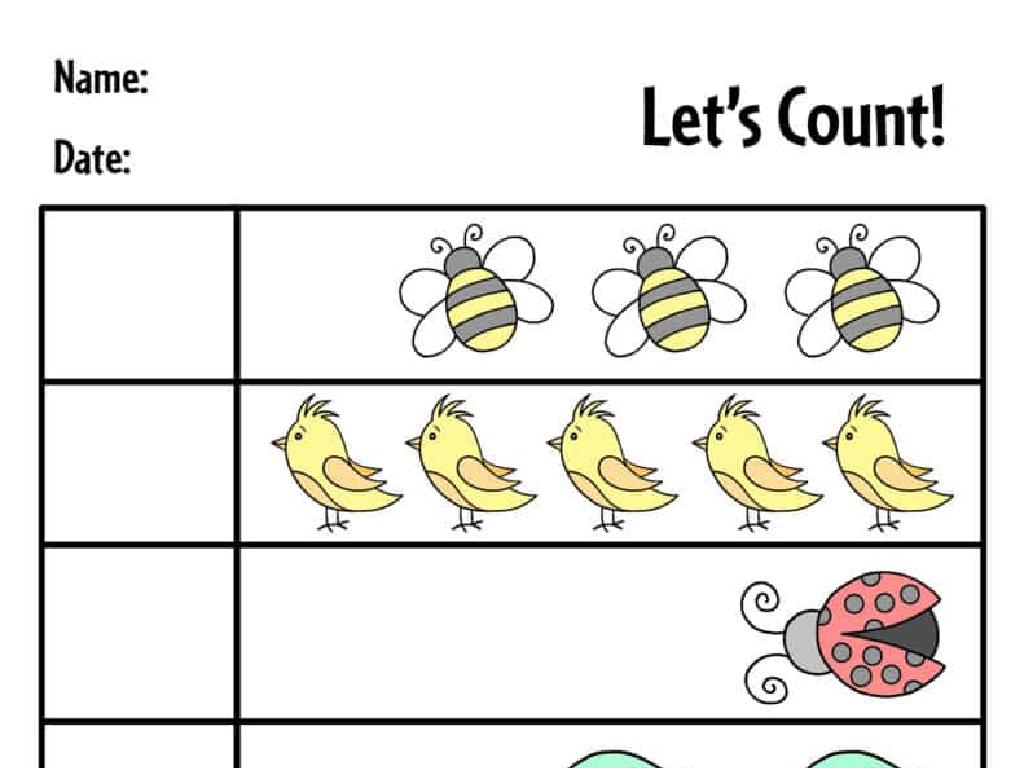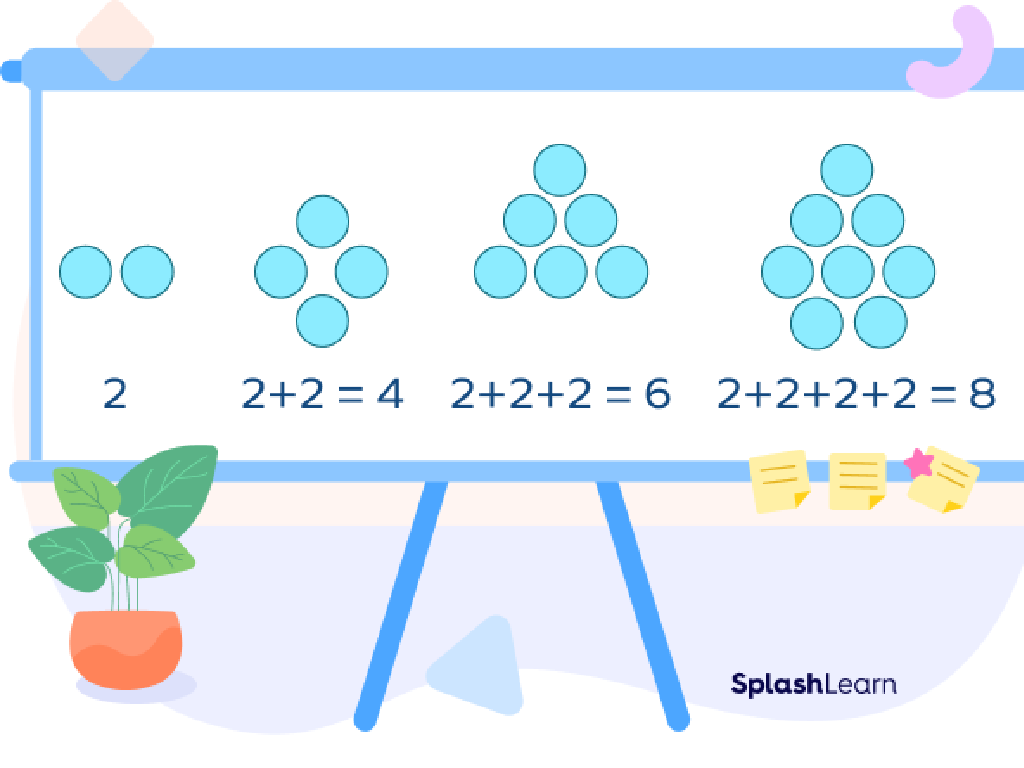Write Equations For Proportional Relationships From Tables
Subject: Math
Grade: Seventh grade
Topic: Proportional Relationships
Please LOG IN to download the presentation. Access is available to registered users only.
View More Content
Writing Equations for Proportional Relationships
– Define proportional relationships
– A relationship where two quantities increase at the same rate.
– Explore real-life proportions
– Examples: recipes, currency exchange, and speed.
– Learn to write equations from tables
– Use a table of values to express the relationship as an equation.
– Today’s goal: Mastering equations
|
This slide introduces the concept of proportional relationships, a fundamental aspect of algebra and real-world problem solving. Begin by defining proportional relationships, emphasizing that they represent a constant rate of change between two quantities. Provide tangible examples, such as ingredients in a recipe or converting currency, to illustrate how proportionality is present in everyday life. The main focus of today’s lesson is to teach students how to translate a table of values into a proportional equation, y = kx, where k is the constant of proportionality. By the end of the lesson, students should be able to identify proportional relationships in tables and write corresponding equations. Encourage students to think of additional examples where they encounter proportions in their daily lives.
Understanding Proportional Relationships
– Define proportional relationship
– A relationship where two quantities increase or decrease at the same rate
– Explore constant of proportionality (k)
– ‘k’ represents the rate of change between y and x
– Equation format: y = kx
– If k = 3, then y triples when x triples. The equation is y = 3x
– Examples of proportional relationships
– If a car travels 60 miles in 1 hour, then in 2 hours it will travel 120 miles (k=60)
|
This slide introduces the concept of proportional relationships, a fundamental aspect of algebra and a key topic in 7th-grade math. Begin by defining a proportional relationship as a situation where two quantities change at a consistent rate. Introduce the constant of proportionality, ‘k’, which is the ratio between two proportional quantities y and x. Explain that the equation y = kx is used to represent this relationship mathematically. Provide examples to illustrate this concept, such as distances traveled over time at a constant speed, or unit price calculations. Encourage students to think of other examples from their daily lives that reflect proportional relationships.
Identifying Proportions in Tables
– Recognize proportional relationships
– If each y/x ratio is constant, the relationship is proportional.
– Find the constant of proportionality
– The constant ratio is the constant of proportionality (k).
– Examples: proportional vs. non-proportional
– Compare tables where k is constant and where it varies.
– Practice with real tables
– Use sample tables to calculate k and determine proportionality.
|
This slide introduces students to the concept of identifying proportional relationships in tables. Start by explaining that in a proportional relationship, the ratio between corresponding values remains constant. Show how to find the constant of proportionality by dividing y by x and checking if this value is the same for all pairs. Provide clear examples of tables that represent proportional and non-proportional relationships, highlighting the differences. Finally, engage students with hands-on practice using real tables to solidify their understanding. Encourage them to explain their reasoning when determining if a table shows a proportional relationship or not.
Writing Equations from Proportional Tables
– Steps to derive an equation
– Calculate the constant (k)
– Divide y by x to find k, the constant of proportionality
– Formulate the equation y = kx
– Use k to write the equation representing the relationship
– Practice with examples
– Apply these steps to different tables to ensure understanding
|
This slide introduces the process of writing equations from tables that show proportional relationships. Start by explaining the steps to derive an equation, emphasizing the importance of understanding the relationship between the variables. Then, guide students on how to calculate the constant of proportionality (k) by dividing the y-value by the corresponding x-value. Once k is determined, instruct students on how to formulate the equation y = kx, where y is the dependent variable, and x is the independent variable. To reinforce the concept, provide several examples of tables with different proportional relationships and work through the process of finding k and writing the equation. Encourage students to practice with additional tables to solidify their understanding.
Practice: Equations from Proportional Tables
– Work through example tables
– We’ll solve tables as a class to learn the process.
– Check for proportional relationships
– A table is proportional if the ratios are equal.
– Write equations for the tables
– Use the formula y = kx, where k is the constant of proportionality.
– Understand proportionality
|
This slide is aimed at providing hands-on practice for students to understand how to derive equations from tables that represent proportional relationships. Start by working through example tables together, ensuring that students are actively involved in the process. Teach them how to determine if a table shows a proportional relationship by checking if the ratio between corresponding values is constant. Once a proportional relationship is established, guide them to write the equation in the form of y = kx, where k is the constant of proportionality. Encourage students to ask questions and provide various tables for them to practice this skill. The goal is for students to become comfortable with identifying proportional relationships and writing equations that represent them.
Group Activity: Find the Equation!
– Break into small groups
– Each group gets a unique table
– Determine the constant of proportionality
– Divide y by x to find the constant, k
– Write the proportional relationship equation
– Use the formula y = kx to express the equation
|
This group activity is designed to encourage collaborative learning as students work together to understand proportional relationships. Each group will analyze a different table of values to find the constant of proportionality, k, which is the ratio between two quantities that are directly proportional to each other. Once k is found, students will use it to write the equation representing the proportional relationship in the form of y = kx, where y is the dependent variable, and x is the independent variable. Provide guidance on how to find k and how to translate that into an equation. Possible activities could include tables with varying complexities, real-life scenarios for application, or even creating their own tables based on given constants of proportionality.
Class Discussion: Proportional Relationships
– Groups share their findings
– Discuss various methods
– How did each group approach the problem?
– Address misunderstandings
– Clarify any confusion about equations or tables
– Reinforce correct concepts
|
This slide is meant to facilitate a class discussion where students will engage in sharing the results of their group work on proportional relationships from tables. Each group will explain their method for writing equations, allowing students to see different approaches to the problem. The teacher should listen to the students’ explanations and step in to address any misunderstandings, ensuring that all students leave with a clear grasp of how to write equations for proportional relationships. The teacher should prepare to explain common errors and reinforce the correct methods for identifying proportional relationships and translating them into equations. This discussion will also help students learn from each other and understand the importance of clear communication in mathematics.
Individual Practice: Proportional Relationships
– Complete the worksheet on your own
– Spot proportional relationships
– Look for pairs of numbers that have a constant ratio
– Write equations for each relationship
– Use the formula y = kx, where k is the constant of proportionality
– Understand the concept of proportionality
– Grasp that proportionality means two quantities increase or decrease at the same rate
|
This slide is aimed at guiding students through individual practice on understanding and writing equations for proportional relationships from tables. Students should complete the provided worksheet independently, which will help reinforce their ability to identify proportional relationships in tabular data. They should look for pairs of numbers where the ratio between them remains constant, indicating a proportional relationship. Once identified, students will write the corresponding equations using the formula y = kx, where k represents the constant of proportionality. This exercise will solidify their comprehension of proportionality as a concept where two quantities maintain a consistent ratio as they change. The teacher should circulate the room to offer assistance and ensure students are correctly identifying proportional relationships and forming the appropriate equations.
Review and Reflect: Proportional Relationships
– Recap of proportional relationships
A proportional relationship is two quantities increasing or decreasing at the same rate.
– Significance of understanding proportions
Knowing proportions is crucial for solving real-world problems, like cooking or budgeting.
– Addressing unanswered questions
– Reflect on today’s learning
Think about how you can apply what you’ve learned to everyday situations.
|
This slide aims to consolidate the students’ understanding of proportional relationships by reviewing the key concepts covered in today’s lesson. Emphasize the importance of understanding proportional relationships in various aspects of daily life and in future mathematical concepts. Encourage students to ask any lingering questions they might have, providing a safe space for inquiry. Finally, prompt students to reflect on what they’ve learned and how they might apply this knowledge outside the classroom. This reflection can help solidify their understanding and recognize the value of what they’ve learned.
Homework: Proportional Relationships Equations
– Practice writing equations from tables
– Use given tables to form y = kx equations
– Understand proportional relationships
– A proportional relationship means two quantities increase at the same rate
– Prepare for upcoming quiz
– Quiz will cover identifying and writing equations for proportional relationships
– Review homework in next class
– We’ll go over common mistakes and clarify doubts
|
This homework assignment is designed to reinforce students’ understanding of proportional relationships and their ability to write equations that represent these relationships from tables. Students should practice with various tables to become comfortable with the concept of the constant of proportionality (k) and how it relates to the equation y = kx. Remind students that in a proportional relationship, as one quantity increases, the other increases at a constant rate, which is reflected in the tables they will work with. The upcoming quiz will assess their ability to identify proportional relationships and write corresponding equations. During the next class, we will review the homework, address any difficulties students encountered, and ensure everyone is prepared for the quiz.





